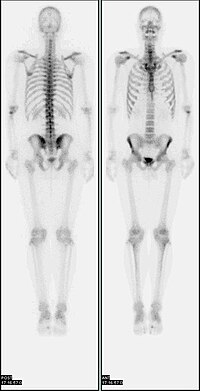
Photo from wikipedia
PurposeCardiac transthyretin-related amyloidosis (ATTR) is a progressive and fatal cardiomyopathy. The diagnosis of this disease is frequently delayed or missed due to the limited specificity of echocardiography. An increasing amount… Click to show full abstract
PurposeCardiac transthyretin-related amyloidosis (ATTR) is a progressive and fatal cardiomyopathy. The diagnosis of this disease is frequently delayed or missed due to the limited specificity of echocardiography. An increasing amount of data in the literature demonstrate the ability of bone scintigraphy with bone-seeking radiopharmaceuticals to detect myocardial amyloid deposits, in particular in patients with ATTR. Therefore we performed a systematic review and bivariate meta-analysis of the diagnostic accuracy of bone scintigraphy in patients with suspected cardiac ATTR.MethodsA comprehensive computer literature search of studies published up to 30 November 2017 on the role of bone scintigraphy in patients with ATTR was performed using the following search algorithm: (a) “amyloid” OR “amyloidosis” AND (b) “TTR” OR “ATTR” OR “transthyretin” AND (c) “scintigraphy” OR “scan” OR “SPECT” OR “SPET” OR “bone” OR “skeletal” OR “skeleton” OR “PYP” OR “DPD” OR “HMDP” OR “MDP” OR “HDP”. Pooled sensitivity, specificity, positive and negative likelihood ratios (LR+ and LR−) and diagnostic odds ratio (DOR) of bone scintigraphy were calculated.ResultsThe meta-analysis of six selected studies on bone scintigraphy in cardiac ATTR including 529 patients provided the following results: sensitivity 92.2% (95% CI 89–95%), specificity 95.4% (95% CI 77–99%), LR+ 7.02 (95% CI 3.42–14.4), LR− 0.09 (95% CI 0.06–0.14), and DOR 81.6 (95% CI 44–153). Mild heterogeneity was found among the selected studies.ConclusionOur evidence-based data demonstrate that bone scintigraphy using technetium-labelled radiotracers provides very high diagnostic accuracy in the non-invasive assessment of cardiac ATTR.
Journal Title: European Journal of Nuclear Medicine and Molecular Imaging
Year Published: 2018
Link to full text (if available)
Share on Social Media: Sign Up to like & get
recommendations!